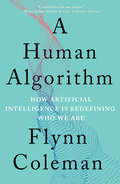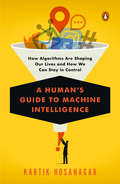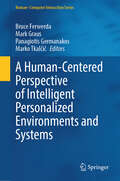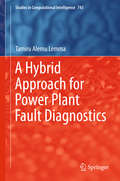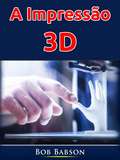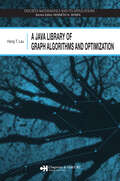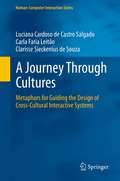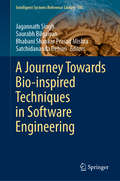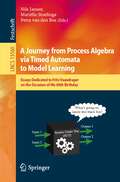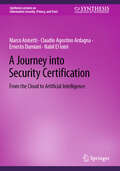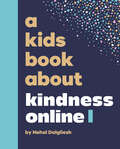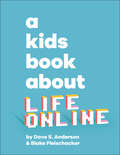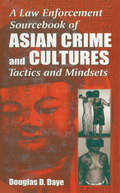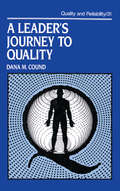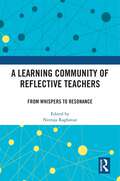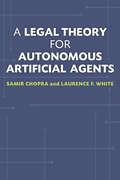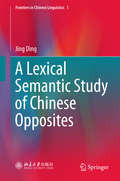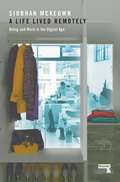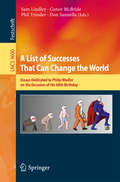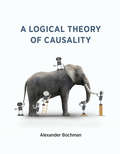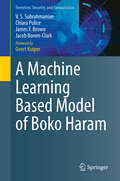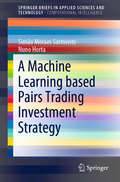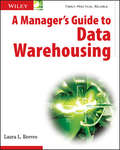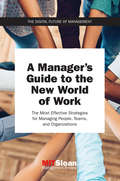- Table View
- List View
A Human Algorithm: How Artificial Intelligence Is Redefining Who We Are
by Flynn ColemanA groundbreaking narrative on the urgency of ethically designed AI and a guidebook to reimagining life in the era of intelligent technology.The Age of Intelligent Machines is upon us, and we are at a reflection point. The proliferation of fast–moving technologies, including forms of artificial intelligence akin to a new species, will cause us to confront profound questions about ourselves. The era of human intellectual superiority is ending, and we need to plan for this monumental shift.A Human Algorithm: How Artificial Intelligence Is Redefining Who We Are examines the immense impact intelligent technology will have on humanity. These machines, while challenging our personal beliefs and our socioeconomic world order, also have the potential to transform our health and well–being, alleviate poverty and suffering, and reveal the mysteries of intelligence and consciousness. International human rights attorney Flynn Coleman deftly argues that it is critical that we instill values, ethics, and morals into our robots, algorithms, and other forms of AI. Equally important, we need to develop and implement laws, policies, and oversight mechanisms to protect us from tech’s insidious threats.To realize AI’s transcendent potential, Coleman advocates for inviting a diverse group of voices to participate in designing our intelligent machines and using our moral imagination to ensure that human rights, empathy, and equity are core principles of emerging technologies. Ultimately, A Human Algorithm is a clarion call for building a more humane future and moving conscientiously into a new frontier of our own design.“[Coleman] argues that the algorithms of machine learning––if they are instilled with human ethics and values––could bring about a new era of enlightenment.” —San Francisco Chronicle
A Human's Guide to Machine Intelligence: How Algorithms Are Shaping Our Lives and How We Can Stay in Control
by Kartik HosanagarA Wharton professor and tech entrepreneur examines how algorithms and artificial intelligence are starting to run every aspect of our lives, and how we can shape the way they impact usThrough the technology embedded in almost every major tech platform and every web-enabled device, algorithms and the artificial intelligence that underlies them make a staggering number of everyday decisions for us, from what products we buy, to where we decide to eat, to how we consume our news, to whom we date, and how we find a job. We've even delegated life-and-death decisions to algorithms--decisions once made by doctors, pilots, and judges. In his new book, Kartik Hosanagar surveys the brave new world of algorithmic decision-making and reveals the potentially dangerous biases they can give rise to as they increasingly run our lives. He makes the compelling case that we need to arm ourselves with a better, deeper, more nuanced understanding of the phenomenon of algorithmic thinking. And he gives us a route in, pointing out that algorithms often think a lot like their creators--that is, like you and me.Hosanagar draws on his experiences designing algorithms professionally--as well as on history, computer science, and psychology--to explore how algorithms work and why they occasionally go rogue, what drives our trust in them, and the many ramifications of algorithmic decision-making. He examines episodes like Microsoft's chatbot Tay, which was designed to converse on social media like a teenage girl, but instead turned sexist and racist; the fatal accidents of self-driving cars; and even our own common, and often frustrating, experiences on services like Netflix and Amazon. A Human's Guide to Machine Intelligence is an entertaining and provocative look at one of the most important developments of our time and a practical user's guide to this first wave of practical artificial intelligence.
A Human-Centered Perspective of Intelligent Personalized Environments and Systems (Human–Computer Interaction Series)
by Marko Tkalčič Panagiotis Germanakos Bruce Ferwerda Mark GrausThis book investigates the potential of combining the more quantitative - data-driven techniques with the more qualitative - theory-driven approaches towards the design of user-centred intelligent systems. It seeks to explore the potential of incorporating factors grounded in psychological theory into adaptive/intelligent routines, mechanisms, technologies and innovations. It highlights models, methods and tools that are emerging from their convergence along with challenges and lessons learned. Special emphasis is placed on promoting original insights and paradigms with respect to latest technologies, current research trends, and innovation directions, e.g., incorporating variables derived from psychological theory and individual differences in adaptive intelligent systems so as to increase explainability, fairness, and transparency, and decrease bias during interactions while the control remains with the user.
A Hybrid Approach for Power Plant Fault Diagnostics (Studies in Computational Intelligence #743)
by Tamiru Alemu LemmaThis book provides a hybrid approach to fault detection and diagnostics. It presents a detailed analysis related to practical applications of the fault detection and diagnostics framework, and highlights recent findings on power plant nonlinear model identification and fault diagnostics. The effectiveness of the methods presented is tested using data acquired from actual cogeneration and cooling plants (CCPs). The models presented were developed by applying Neuro-Fuzzy (NF) methods. The book offers a valuable resource for researchers and practicing engineers alike.
A Impressão 3D
by Bob BabsonGostaria de comprar uma impressora 3D mas não tem ideia de qual comprar? Gostaria de aprender como começar com as impressoras 3D, com o objetivo de imprimir objetos e designs incríveis? Nesse livro você irá aprender tudo sobre a impressão 3D e como começar. Aprenda: -Como começar -Qual impressora 3D comprar -Características e capacidade das impressoras 3D + MUITO MAIS!
A Java Library of Graph Algorithms and Optimization (Discrete Mathematics and Its Applications)
by Hang T. LauBecause of its portability and platform-independence, Java is the ideal computer programming language to use when working on graph algorithms and other mathematical programming problems. Collecting some of the most popular graph algorithms and optimization procedures, A Java Library of Graph Algorithms and Optimization provides the source code for
A Journey Through Cultures: Metaphors for Guiding the Design of Cross-Cultural Interactive Systems (Human–Computer Interaction Series)
by Clarisse Sieckenius Souza Carla Faria Leitão Luciana Cardoso SalgadoA Journey Through Cultures addresses one of the hottest topics in contemporary HCI: cultural diversity amongst users. For a number of years the HCI community has been investigating alternatives to enhance the design of cross-cultural systems. Most contributions to date have followed either a 'design for each' or a 'design for all' strategy. A Journey Through Cultures takes a very different approach. Proponents of CVM - the Cultural Viewpoint Metaphors perspective - the authors invite HCI practitioners to think of how to expose and communicate the idea of cultural diversity. A detailed case study is included which assesses the metaphors' potential in cross-cultural design and evaluation. The results show that cultural viewpoint metaphors have strong epistemic power, leveraged by a combination of theoretic foundations coming from Anthropology, Semiotics and the authors' own work in HCI and Semiotic Engineering. Luciana Salgado, Carla Leitão and Clarisse de Souza are members of SERG, the Semiotic Engineering Research Group at the Departamento de Informática of Rio de Janeiro's Pontifical Catholic University (PUC-Rio).
A Journey Towards Bio-inspired Techniques in Software Engineering (Intelligent Systems Reference Library #185)
by Bhabani Shankar Prasad Mishra Satchidananda Dehuri Jagannath Singh Saurabh BilgaiyanThis book covers a range of basic and advanced topics in software engineering. The field has undergone several phases of change and improvement since its invention, and there is significant ongoing research in software development, addressing aspects such as analysis, design, testing and maintenance. Rather than focusing on a single aspect of software engineering, this book provides a systematic overview of recent techniques, including requirement gathering in the form of story points in agile software, and bio-inspired techniques for estimating the effort, cost, and time required for software development. As such it is a valuable resource for new researchers interested in advances in software engineering — particularly in the area of bio-inspired techniques.
A Journey from Process Algebra via Timed Automata to Model Learning: Essays Dedicated to Frits Vaandrager on the Occasion of His 60th Birthday (Lecture Notes in Computer Science #13560)
by Mariëlle Stoelinga Nils Jansen Petra van den BosThis Festschrift, dedicated to Frits W. Vaandrager on the occasion of his 60th birthday, contains papers written by many of his closest collaborators. Frits has been a Professor of Informatics for Technical Applications at Radboud University Nijmegen since 1995, where his research focuses on formal methods, concurrency theory, verification, model checking, and automata learning. The volume contains contributions of colleagues, Ph.D. students, and researchers with whom Frits has collaborated and inspired, reflecting a wide spectrum of scientific interests, and demonstrating successful work at the highest levels of both theory and practice.
A Journey into Security Certification: From the Cloud to Artificial Intelligence (Synthesis Lectures on Information Security, Privacy, and Trust)
by Ernesto Damiani Claudio Agostino Ardagna Nabil El Ioini Marco AnisettiThis book, authored by some of the pioneers in the security certification domain, provides a foundational knowledge base for designing and deploying effective security certification schemes for cloud-edge distributed systems. It gives readers unique and essential insight into the history of security certification and its evolution from static to dynamic models. The book helps readers to understand the importance of security certification across distributed system evolution from cloud-based to artificial intelligence-machine learning systems. It covers in full the certification of cloud-based composite services, discussing the role of multi-factor certification. It also emphasizes processes for continuously certifying services across system and context changes, as well as the certification of the deployment environment and development process and their impact on the overall cloud service certification. The book considers and challenges existing security certification schemes for cloud services, discussing issues and gaps when applied to modern systems in the cloud-edge continuum and built on artificial intelligence. Readers will become familiar with the challenges in certifying cloud-edge distributed systems and machine learning-based systems. This book also provides actionable insight to readers who manage modern security systems. Security controls have grown in size and complexity, requiring reliable and sustainable certification schemes to support varying quality standards and produce compliant products. It covers the logic behind security standards and the evaluation criteria of main certification standards, further discussing the evolution and corresponding certification of distributed systems towards cloud, cloud-edge, and artificial intelligence. The book teaches readers how to build faster, scalable, and more reliable cloud-edge distributed systems and beyond.
A Kids Book About Kindness Online (A Kids Book)
by Nehal Alavi DalglieshShowing kindness online is necessary for shaping a healthy, compassionate digital world!This is a kids’ book about kindness online. Acting with kindness and compassion really matters – did you know that the way we treat others online is just as important as in real life? It's true! But what does that mean?This book was made to help kids aged 5-9 understand the importance of pursuing kindness in all our online interactions. In this book, kids will learn how we can create a kind online world. We are shaping our digital world every day – what kind of world do you want to live in?A Kids Book About Kindness Online features: A large and bold, yet minimalist font design that allows kids freedom to imagine themselves in the words on the pages.A friendly, approachable, empowering, and child-appropriate tone throughout.An incredible and diverse group of authors in the series who are experts or have first-hand experience of the topic.Tackling important discourse together! The A Kids Book About titles are best used when read together. Helping to kickstart important, challenging, and empowering conversations for kids and their grown-ups through beautiful and thought-provoking pages. The series supports an incredible and diverse group of authors, who are either experts in their field, or have first-hand experience on the topic. A Kids Co. is a new kind of media company enabling kids to explore big topics in a new and engaging way, with a growing series of books, podcasts, and blogs made to empower. Learn more about us online by searching for A Kids Co.
A Kids Book About Life Online (A Kids Book)
by Dave S. Anderson Blake FleischackerA clear explanation of what the online world can be like, helping to navigate life in a world surrounded by technology.Kids today are growing up with social media and life online, which may have differed from how their grownups grew up! Life online isn&’t a bad thing, and it isn&’t necessarily a good thing either. This book shows kids aged 5-9 that how you hang out online can tell the whole world about who you are, and that when you show up authentically, creatively, and kindly, you can help change the world! Teach kids the importance of kindness, empathy and inclusion, especially when interacting with others online.A Kids Book About Life Online features: - A large and bold, yet minimalist font design that allows kids freedom to imagine themselves in the words on the pages.- A friendly, approachable, yet empowering, kid-appropriate tone throughout.- An incredible and diverse group of authors in the series who are experts or have first-hand experience of the topic.Tackling important discourse together! The A Kids Book About series are best used when read together. Helping to kickstart important, challenging, and empowering conversations for kids and their grownups through beautiful and thought-provoking pages. The series supports an incredible and diverse group of authors, who are either experts in their field, or have first-hand experience on the topic. A Kids Co. is a new kind of media company enabling kids to explore big topics in a new and engaging way. With a growing series of books, podcasts and blogs, made to empower. Learn more about us online by searching for A Kids Co.
A Law Enforcement Sourcebook of Asian Crime and CulturesTactics and Mindsets
by Douglas D. DayeEven in multicultural North America, few whites, blacks, or Hispanics have extensive experience or understanding of Asian culture. For experienced police officers, intelligence analysts, correctional officers, and prosecutors, the problems of cultural differences in behavior remain complex and problematic. This book addresses these specific law enforcement problems, and supplies law enforcement professionals with information and strategies for easier arrests, more accurate intelligence, more successful prosecutions, and fewer problems during incarceration.
A Leader's Journey to Quality
by Dana M. CoundThis book deals with the "hard skills" involved in achieving leadership quality. It provides a vehicle to foster interaction of the elements of the modern approach to quality, including statistical applications, quality and reliability engineering, management, and motivational aspects.
A Learning Community of Reflective Teachers: From Whispers to Resonance
by Neeraja RaghavanTeachers possess a wealth of untapped wisdom and valuable experience. Whether it’s in matter of educational policy, curriculum development or textbook selection, teachers carry a trove of information and insights to share. Traditionally, teacher development has been driven by administrators of schools, and it often takes the form of a ‘mentor’ teaching the staff of a school. But what happens when teachers across different locations collaborate and learn together? This volume documents such an initiative, sparked off by the Covid-19 pandemic, which brought people together online. It underscores the power of teachers debating, discussing, and learning from each other. Based on an Indian experience, the book addresses a range of issues teachers and educators face across the world — encompassing pedagogy, classroom management, school culture and teacher development. A unique story of community building and teacher education, this book also contains key outcomes and insights which take us through their action research projects and showcases a model of teacher development that can be adopted by interested readers. Above all, it brings out the crying need for a teacher’s voice to be heard — for far too long, teachers have been mere implementers of decisions taken by policy makers or managements of schools. By means of networking communities such as the one described in this book, the transformation of teachers going from whispers to resonance is greatly amplified. An important intervention in the domain of teacher development, this volume will be of great interest to students, researchers and practitioners of education, teacher education, and sociology of education. It will also be useful for teacher trainees, academicians, teacher educators, policymakers, schoolteachers, curriculum developers, teacher training institutes, and universities offering teacher education programs.
A Legal Theory for Autonomous Artificial Agents
by Samir Chopra Laurence F. WhiteAs corporations and government agencies replace human employees with online customer service and automated phone systems, we become accustomed to doing business with nonhuman agents. If artificial intelligence (AI) technology advances as today's leading researchers predict, these agents may soon function with such limited human input that they appear to act independently. When they achieve that level of autonomy, what legal status should they have?
A Lexical Semantic Study of Chinese Opposites (Frontiers in Chinese Linguistics #1)
by Jing DingThis book studies Chinese opposites. It uses a large corpus (GigaWord) to trace the behavior of opposite pairings' co-occurrence, focusing on the following questions: In what types of constructions, from window-size restricted and bi-syllabic to quad-syllabic, will the opposite pairings appear together? And, on a larger scale, i. e. in constrained-free contexts, in which syntactic frames will the opposite pairings appear together? The data suggests aspects that have been ignored by previous theoretical studies, such as the ordering rules in co-occurrent pairings, the differences between the three main sub-types of opposites (that is, antonym, complementary, converse) in discourse function distributions. The author also considers the features of this Chinese study and compares it to similar studies of English and Japanese. In all, it offers a practical view of how opposites are used in a certain language as a response to the puzzles lingering in theoretical fields. This study appeals to linguists, computational linguists and language-lovers. With numerous tables, illustrations and examples, it is easy to read but also encourages readers to link their personal instincts with the results from a large corpus to experience the beauty of language as a shared human resource.
A Life Lived Remotely
by Siobhan McKeownWhat happens when we take our lives online? How are we being changed by immersion in the internet? How do we know the difference between work and life when one seems to blend into the other?Part memoir, part theory, A Life Lived Remotely tells the story of a transition to the digital age. It follows the author's journey through remote work, framing it within the exponential growth of the internet and the rapid spread of neoliberalism. It examines how we are being changed by the internet, how we experience that change, and at the anxieties and issues that arise. A moment's pause in a world of fast-paced communication, it provides a critical reflection on what it means to come of age along with the internet.
A List of Successes That Can Change the World: Essays Dedicated to Philip Wadler on the Occasion of His 60th Birthday (Lecture Notes in Computer Science #9600)
by Sam Lindley Conor Mcbride Phil Trinder Don SannellaThis volume is published in Honor of PhilipWadler on the occasion of his 60th birthday, and the collection of papers forma Festschrift for him. The contributions are made by some of the many who knowPhil and have been influenced by him. The research papers included hererepresent some of the areas in which Phil has been active, and the editorsthank their colleagues for agreeing to contribute to this Festschrift. We attemptto summarize Phil Wadler's scientific achievements. In addition, we describethe personal style and enthusiasm that Phil has brought to the subject.
A Logical Theory of Causality
by Alexander BochmanA general formal theory of causal reasoning as a logical study of causal models, reasoning, and inference.In this book, Alexander Bochman presents a general formal theory of causal reasoning as a logical study of causal models, reasoning, and inference, basing it on a supposition that causal reasoning is not a competitor of logical reasoning but its complement for situations lacking logically sufficient data or knowledge. Bochman also explores the relationship of this theory with the popular structural equation approach to causality proposed by Judea Pearl and explores several applications ranging from artificial intelligence to legal theory, including abduction, counterfactuals, actual and proximate causality, dynamic causal models, and reasoning about action and change in artificial intelligence. As logical preparation, before introducing causal concepts, Bochman describes an alternative, situation-based semantics for classical logic that provides a better understanding of what can be captured by purely logical means. He then presents another prerequisite, outlining those parts of a general theory of nonmonotonic reasoning that are relevant to his own theory. These two components provide a logical background for the main, two-tier formalism of the causal calculus that serves as the formal basis of his theory. He presents the main causal formalism of the book as a natural generalization of classical logic that allows for causal reasoning. This provides a formal background for subsequent chapters. Finally, Bochman presents a generalization of causal reasoning to dynamic domains.
A Machine Learning Based Model of Boko Haram (Terrorism, Security, and Computation)
by V. S. Subrahmanian Chiara Pulice James F. Brown Jacob Bonen-ClarkThis is the first study of Boko Haram that brings advanced data-driven, machine learning models to both learn models capable of predicting a wide range of attacks carried out by Boko Haram, as well as develop data-driven policies to shape Boko Haram’s behavior and reduce attacks by them. This book also identifies conditions that predict sexual violence, suicide bombings and attempted bombings, abduction, arson, looting, and targeting of government officials and security installations. After reducing Boko Haram’s history to a spreadsheet containing monthly information about different types of attacks and different circumstances prevailing over a 9 year period, this book introduces Temporal Probabilistic (TP) rules that can be automatically learned from data and are easy to explain to policy makers and security experts. This book additionally reports on over 1 year of forecasts made using the model in order to validate predictive accuracy. It also introduces a policy computation method to rein in Boko Haram’s attacks.Applied machine learning researchers, machine learning experts and predictive modeling experts agree that this book is a valuable learning asset. Counter-terrorism experts, national and international security experts, public policy experts and Africa experts will also agree this book is a valuable learning tool.
A Machine Learning based Pairs Trading Investment Strategy (SpringerBriefs in Applied Sciences and Technology)
by Nuno Horta Simão Moraes SarmentoThis book investigates the application of promising machine learning techniques to address two problems: (i) how to find profitable pairs while constraining the search space and (ii) how to avoid long decline periods due to prolonged divergent pairs. It also proposes the integration of an unsupervised learning algorithm, OPTICS, to handle problem (i), and demonstrates that the suggested technique can outperform the common pairs search methods, achieving an average portfolio Sharpe ratio of 3.79, in comparison to 3.58 and 2.59 obtained using standard approaches. For problem (ii), the authors introduce a forecasting-based trading model capable of reducing the periods of portfolio decline by 75%. However, this comes at the expense of decreasing overall profitability. The authors also test the proposed strategy using an ARMA model, an LSTM and an LSTM encoder-decoder.
A Manager's Guide to BS25999
by Tony DrewittThis book is a concise and practical guide to implementing the new benchmark for business continuity management - BS25999. While the number of events that could potentially disrupt the ability of your organization to continue with its business activities continues to grow, the ramifications are increasingly dramatic. Climate change, terrorism and IT system failure are just some of today's more serious threats - and pressure is growing on all organizations to demonstrate effective, meaningful and dependable emergency preparedness. This guide will help you understand and meet the growing need to demonstrate and provide assurance to partners, customers and stakeholders that, should some significant business disruption occur, you have done everything possible to minimize disruption to the continued supply of the products or services by your organization.
A Manager's Guide to Data Warehousing
by Laura ReevesAimed at helping business and IT managers clearly communicate with each other, this helpful book addresses concerns straight-on and provides practical methods to building a collaborative data warehouse . You'll get clear explanations of the goals and objectives of each stage of the data warehouse lifecycle while learning the roles that both business managers and technicians play at each stage. Discussions of the most critical decision points for success at each phase of the data warehouse lifecycle help you understand ways in which both business and IT management can make decisions that best meet unified objectives.
A Manager's Guide to the New World of Work: The Most Effective Strategies for Managing People, Teams, and Organizations (The Digital Future of Management)
by MIT Sloan Management ReviewThe best tools and insights to succesfully navigate the novel challenges of the digital workplace.How can technology and analytics help companies manage people? Why do teams working remotely still need leaders? When should organizations use digital assessment tools for gauging talent and potential? This book from MIT Sloan Management Review answers questions managers are only beginning to ask, presenting insights and stories from organizations navigating the novel challenges of the digital workplace. Experts from business and academia describe what's worked, what's failed, and what they've learned in the new world of work, looking at strategies that organizations use to help managers and employees adapt to the fast-changing digital environment.
